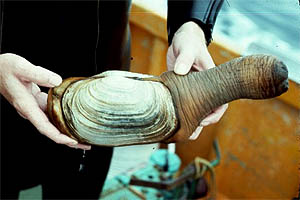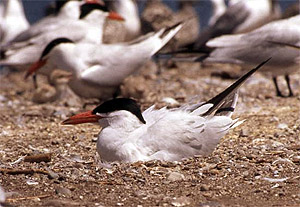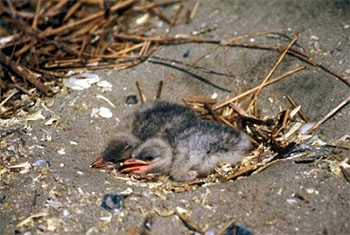
|
|||||||||||||||
|
| |||||||||||||||
Plants and animals begin to grow and reproduce Just as in the open ocean, April is a time of quickening in coastal estuaries. Though most upwelling takes place in the exposed coastal areas, the nutrients brought to surface during upwelling events affect all parts of the Central Coast, including coastal estuaries. For example, under strong upwelling conditions, each incoming tide may bring a pulse of nitrate and other algal nutrients into Elkhorn Slough. These nutrients, along with increasing sunlight, spur the growth of diatoms, green algae, and eel grass in coastal wetlands in spring. This plant material provides food for copepods, amphipods, worms, and other small animals, which reproduce rapidly as the waters in the slough warm in the sun. These small animals, in turn, provide food for the fish such as staghorn sculpin and anchovies, which use the slough as a nursery in spring. In addition to these smaller fish, young predatory fish such as English sole, California halibut, and starry flounder are still abundant in the slough in April. Since February, these young flatfish have been hanging out in the estuary gorging themselves on smaller fish and bottom-dwelling animals. By the end of April, however, the flatfish will start migrating out to the open waters of Monterey Bay, where they will live as adults. The spring bumper crop of copepods in the slough feeds not only small fish, but also a host of smaller creatures. Among these are the colonial animals known as hydroids, which look like tiny sea anemones growing on branched stalks. Hydroids in the genus Sarcia reproduce in spring and summer, when there are plenty of copepods to eat. Like the moon jellies described in March, Sarcia hydroids reproduce by releasing medusae that look like microscopic jellyfish. These medusae drift with the currents, eating copepods and other microscopic animals. Geoduck clams spawn  A geoduck clam, out of its burrow for once and only time. (Source: Fisheries and Oceans Canada) Another slough dweller that benefits from spring diatom blooms is the geoduck clam (Panopea generosa). Geoducks spawn during April and May, when plenty of food is available both for themselves and for their young. At peak high tide, each geoduck releases millions of eggs and sperm into the slough waters. Fertilized eggs develop into microscopic, drifting larvae that are carried out of the slough on the falling tide, to drift at sea for about seven months. In late fall, a few surviving geoduck larvae will somehow find their way back into Central Coast estuaries, where they will settle down to the muddy bottom and dig themselves in. The word geoduck is pronounced "gooeyduck" and comes from a Chinook word meaning "dig deeply." In fact, geoduck clams spend their adult lives embedded three to four feet in the muddy bottoms of coastal estuaries. They breath and eat through hose-like siphons that extend up to the surface of the mud. After sucking water down from the surface, the geoducks filter out organic debris and microscopic algae for food. Once established in the mud, geoducks can live for over 140 years, grow shells up to ten inches across, and have bodies that weigh over 20 pounds. As one marine biologist put it, they are "truly noble bivalves." If a human or other predator tries to dig deeply to get at a geoduck, the first thing the clam does is rapidly withdraw its siphon down into its burrow. Although the clam can't fit all of its siphon and body inside its shell, this extra bulk just makes the animal harder to pull up out of the mud. If a predator does get a grip on a geoduck siphon, the siphon simply breaks off, allowing the geoduck to escape and grow a new siphon. In fact, crabs, bat rays, halibut, and sea otters have been known to take advantage of this fact, by "grazing" on clam siphons, which are apparently a renewable resource. Unfortunately, humans are not as easily satisfied, especially when money is involved. In many estuaries, geoduck populations have been severely reduced by human predation. Wetland and shore birds migrate through the slough In April, estuaries along the Central Coast serve as essential rest stops and feeding areas for thousands of migrating wetland birds and shorebirds. In addition to the seabirds and shore birds already described, these migrants include plovers, curlews, avocets, ducks, geese, and small plankton eaters such as dunlins and dowitchers. Most of these birds are on their way to breeding grounds in Alaska and Canada. As the month progresses and stragglers arrive, the flocks of migrants increase in size. By the middle of May, only a few stragglers will remain. Caspian terns, egrets, and herons nest in the slough Even after the hoards of migrating birds have left the slough, several species of sea birds will stay behind to nest locally. These include Brandt's cormorants and Western gulls, which nest on abandoned wharfs and navigation markers. Western gulls always seem to nest near other birds' rookeries, so that they can prey on the eggs and young of their neighbors. Caspian terns build nests  Caspian tern nesting. (Source: Bryan Harry, National Parks Service) Aside from nesting Brandt's cormorants and Western gulls (discussed under April seabirds), another seabird that regularly nests in Elkhorn Slough is the Caspian tern (Sterna caspia). In April and May you can often see newly arrived Caspian terns flying out over the Slough and coastal waters, searching for small fish near the water surface. Caspian terns nest on small islands in the slough or near river mouths, which are usually inaccessible to terrestrial predators such as raccoons, foxes, and dogs. However, sometimes these predators do find their way out to the tern nesting areas during very low tides. When this happens, virtually all of the tern eggs or young may be killed in a single gruesome feeding frenzy. The first Caspian terns often arrive on the Central Coast in late March or early April, soon after the first spring upwelling events. The terns spend their winters feeding along the coast of Mexico and Central America. In addition to gathering at Elkhorn Slough in April, Caspian terns also congregate around the mouths of the Salinas and Pajaro Rivers, as well as near old salt ponds around the edges of San Francisco Bay.  Caspian tern chicks are helpless at birth, and easy prey for foxes or raccoons that can reach nesting sites at low tide. Their nest is little more than a pit scraped in the sand. (Source: Donna Dewhurst, U.S. Fish and Wildlife Service) By mid April, the terns are busy building their nests. However, "building" may be too strong a word, since these nests are typically just shallow pits scraped out of the dirt. Small groups of terns often nest together, their nests evenly spaced a few feet apart from one another. Snowy egrets and blue herons build nests Although Caspian terns prefer isolated islands on which to nest, other birds are not so picky. In spring, Snowy egrets and blue herons nest in willows, pines, and eucalyptus trees along the edges of the slough. These rookeries are often loud and busy places. The abundant young fish in the slough at this time of year provide plenty of food for the egrets and herons and their young. |
